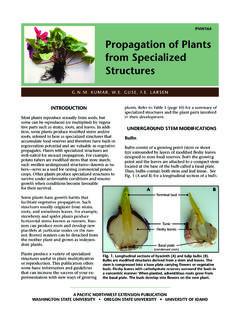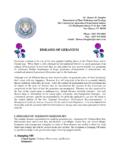Transcription of Growing from seed - Tamborine Mountain …
1 propagation PROTOCOLS This document is intended as a guide for Tamborine Mountain Landcare members who wish to assist our regeneration projects by Growing some of the plants needed. It is a work in progress so if you have anything to add to the protocols for example a different but successful way of propagating and Growing a particular plant then please give it to Julie Lake so she can add it to the document. The idea is that our shared knowledge and experience can become a valuable part of TML's intellectual property as well as a useful source of knowledge for members. As there are many hundreds of plants native to Tamborine Mountain , the protocols list will take a long time to complete, with Growing information for each plant added alphabetically as time permits.
2 While the list is being compiled by those members with competence in this field, any TML member with a query about propagating a particular plant can post it on the website for other m e m b e r s to answer. To date, only protocols for trees and shrubs have been compiled. Vines and ferns will be added later. Fruiting times given are usual for the species but many rainforest plants flower and fruit opportunistically, according to weather and other conditions unknown to us, thus fruit can be produced at any time of year. Finally, if anyone would like a copy of the protocols, contact Julie on and she ll send you one.. Growing from seed This is the best method for most plants destined for regeneration projects for it is usually fast, easy and ensures genetic diversity in the regenerated landscape.
3 COLLECTING seed As a general note, seed is best collected while still on the tree or bush. With seed contained within a fleshy fruit, the colour of the fruit at maturity must be known because only seed from ripe fruit is viable. seed on the ground is too often contaminated by parasites to be useful; lilly pilly (Syzygium spp.) are very often infected in this way. Some fruit, for example Blue Quandong (Elaeocarpus grandis) CAN be collected from the ground but a careful check should be made to see that the fruit is intact and in good condition firm, unmarked and not too wrinkled. The same advice applies to seeds in capsules ( Dysoxylum, Jagera, Sloanea) collect from the tree and only take from the ground if you can be sure it has fallen within the past few hours.
4 SEE PAPER ON seed COLLECTION FOR GENETIC DIVERSITY AVAILABLE FROM JULIE Collected seed should be placed in a clean brown paper (preferably) or plastic bag and kept in a cool, dry place ( NOT a hot car!) until it can be home. seed from most rainforest plants has short viability so should be treated (if necessary) and sown within 24 hours of collection. seed with longer viability can be stored in the frig. seed should not be collected from a National Park and permission is needed to collect seed on privately-owned or local authority land. CLEANING AND TREATING seed Equipment: 1 large sharp knife and 1 small sharp knife. Gloves (some seeds have irritating hairs or contain irritating chemicals).
5 Large, strong sieve. (Old screen doors can be used if you are cleaning large quantities of seed ). Hair dryer (for drying damp seed in a hurry). Buckets or basins for soaking seed . Cleaning All seed should be removed from the seed case, or have the outer flesh and/or aril removed before sowing; removal of outer flesh is particularly important with fruits that in nature are eaten by birds that then excrete the seed . Flesh remaining on the seed encourages fungal disease and can inhibit germination. Thorough cleaning is only required if seed is to be stored, to prevent rot. Some seed needs to be soaked for up to 48 hours to get rid of grubs. This also helps to dissolve the waxy coating on some seeds.
6 Small seeds with a lot of soft flesh attached can be rubbed through a sieve. Treatment Some seeds require special treatment to initiate germination. With a few species such treatment is so specialised and difficult that we shan't deal with it here but focus on those plants that can be propagated reasonably easily in the home garden. Other seeds have very hard coats and need a lot of processing so that germination can take place. The usual method is to nick them with a sharp knife to allow water to penetrate through the outer coating. Seeds of Alphitonia and Commersonia, both used extensively in our regeneration projects, should be first boiled for about five minutes and then left to soak for 48 hours.
7 Here are the more common types of fruit and how to deal with them: Crisp, fleshy fruit, single seed : (Syzygium spp., many Lauraceae,) Break open, peel or cut fruit and remove seed . Soak for 48 hours in warm water then clean with a hard brush or steel wool to remove any remaining flesh. Crisp, fleshy fruit with a few large seeds: Same as above Large, firm fruit containing hard capsule (stone) protecting the seed (kernel): (Elaeocarpus, Macadamia). Stone needs to be nicked, filed, cracked or heated to allow seed kernel to germinate, however this can kill the seed if it isn t mature enough to germinate. With some plants it is necessary to sow the seed and wait, perhaps for several years, before germination occurs naturally (in such cases cuttings might be a short-term solution).
8 See individual plants for information. Fleshy fruits with multiple small seeds: (Ficus, Tasmannia, Rubus) Soak and rub through a sieve if seeds are not large enough to be easily removed. Fruits containing very tiny seeds can be crumbled up in a container of fine sand; rub the mixture around to abrade and thus clean the seed , then sow the seed /sand mix. Capsules with hard seeds covered by arils: (Dysoxylum, Sloanea, Jagera and other Sapindaceae): Remove seed from capsule, remove aril (outer coating) and sow immediately. Capsules may need to be cut or broken open. Drying in an oven (not microwave) or in a pot over a barbecue can be used to open capsules of certain plants, but requires expertise so that the seed is not damaged by over-heating.
9 This applies also to drying capsules in open sunlight, as is done with some non-rainforest plants. Capsules with many tiny seeds: (Caldcluvia, Quintinia, Lophostemon): Remove seeds from capsule (using great care as they are easily lost or blown away) and sow on top of a coarse medium such as peat or an orchid mix; cover with fine netting, shadecloth or any material which will protect the seeds from drying out but won't allow them to become too moist, particularly in humid weather. Capsules containing winged, usually papery, seeds: (Argyrodendron, Backhousia, Flindersia): Remove seed from capsule and sow, with a very light covering of Growing medium, sand or even perlite/vermiculite.
10 With really difficult seed such as that of wattles and many pea flowers (Hovea, Pultenaea etc.) the seed should be soaked in boiling water and left for at least a week, changing the water every three days. Coca cola has been used successfully to germinate seeds such as Gahnia (a sedge) and experiments are being done with vinegar and citric acid. STORING seed Most fleshy fruits do not store well and seed should be sown as soon after collection as possible. Where seed IS to be stored, remove outer flesh and clean seed thoroughly with a stiff brush or steel wool. Dry seed before sowing, in the sun or with a towel; too much moisture on the seed coat encourages pathogen disease, rotting and seedling damping off.





